![]()
![]()
![]()
Use LEFT and RIGHT arrow keys to navigate between flashcards;
Use UP and DOWN arrow keys to flip the card;
H to show hint;
A reads text to speech;
45 Cards in this Set
- Front
- Back
|
alimentary tract |
A muscular tube lined internally by an epithelium
|
|
|
functions of alimentary tract |
|
|
|
oral cavity |
|
|
|
transport passages of alimentary tract |
Pharynx Oesophagus Anal canal
Some mucous glands – lubrication |
|
|
digestive tract |
Stomach Small intestine (duodenum, jejunum, ileum) Large intestine (caecum, appendix, colon, rectum)
|
|
|
4 layers of alimentary canal |

-epithelium -lamina propria -muscularis mucoase
-longitudinal and circular muscle
-epithelium -connective tissue |
|
|
Mucosa |
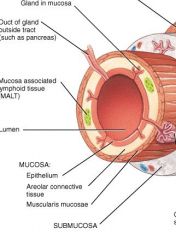
|
|
|
submucosa |
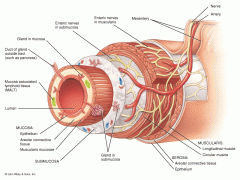
|
|
|
Muscularis externa
|
|
|
|
serosa/adventitia |
|
|
|
increasing surface area improves.... |
efficiency of absorption (plica circulares) |
|
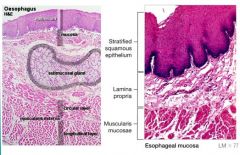
oesophagus |
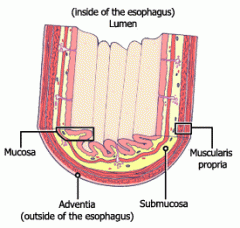
~25cm long, leads through diaphragm to stomach Mucosa Muscularis externa Adventitia
|
|
|
stomach |
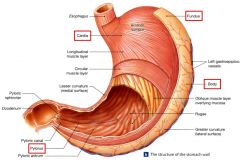
|
|
|
gastric mucosa (stomach) |
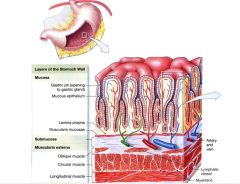
|
|
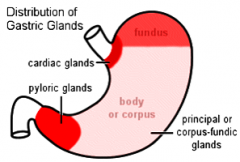
gastric glands (stomach) |
|
|
|
gastric gland cells (stomach) |

|
|
|
subdivisions of small intestine |
|
|
|
small intestine- mucosa |
|
|
|
small intestine-submucosa |

|
|
|
small intestine |

|
|
|
large intestine- 3 main sections |
Three main sections: Anal Canal: -epithelium changes from columnar to stratified squamous
|
|
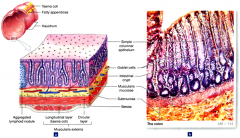
large intestine- mucosa |
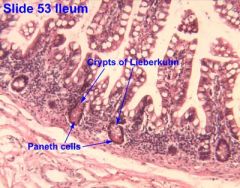
-Surface relatively smooth – no plicae or villi -Crypts of Lieberkühn – present and longer than S.I. -Columnar epithelium
Muscularis Externa -difference to small intestine -longitudinal layers form 3 flattened strands (taenia coli) Serosa -forms small pouches pilled with adipose along the large intestine |
|
|
accessory glands of digestive system |
Salivary glands -secretes lubricating fluid +enzymes that break down carbs
Liver bile- lipid digestion. bile=steroid acid from cholic acid/cholesterol act as surfactant emulsifying fats in food.
Gall bladder -stores and concentrates bile
Pancreas -exocrine cells= fluids and enzymes -endo cells- hormones |
|
|
dietary fluid input |
2000mL |
|
|
Alimentary tract secretions |
-saliva= 1500 ml -gastric secretions=1500 ml -liver (bile)- 1000 ml -pancreas (pan juices)- 1000 ml -Intestinal secretions- 2000 ml -Colon mucus secretions 200ml |
|
|
water reabsorption |
-small intestine 7800ml -colon- 1250ml |
|

salivary glands |
Saliva is a mixed secretion, derived from numerous large and small salivary glands
Small salivary glands
Large Salivary Glands
|
|
|
glands located close to oral cavity secrete________ |
mucous secreting |
|
|
glands distant to cavity secrete_______ |
serous |
|
|
sublingual salivary gland are mainly what type of gland |
mucous acini |
|
|
submandibular gland secrete___________ |
both serous and mucous acini |
|
|
parotid gland |
almost exclusively serous acini |
|
|
serous secretions consist mainly of |
enzymes like alpha-amylase |
|
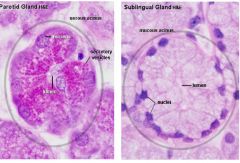
mucous secretions secrete |
mucins- heavily glycosylated protein -involved in lubrication |
|
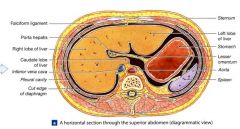
The liver |
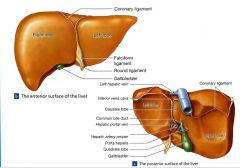
|
|
|
Liver vasculature
|
|
|
|
liver lobule |

|
|
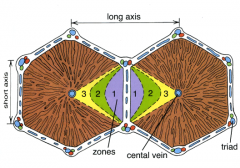
liver zones |

|
|
|
hepatc bile production |
|
|
|
bile secretion |
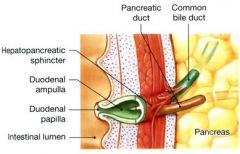
- Terminal bile ducts (lined by cuboidal epithelium) - Intrahepatic bile ducts (columnar) - Coalesce into left and right hepatic ducts (columnar) - Unite to form common hepatic duct (columnar) - Cystic duct (to/from gallbladder) & bile duct (to duodenum)
|
|
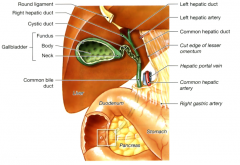
Gall bladder |
Mucos - Columnar epithelium, microvilli (resorption of water from bile)a - No mucus-producing cells - No muscularis mucosae
|
|
|
Cholecystokinin (CCK )
|

|
|
|
The pancreas
|
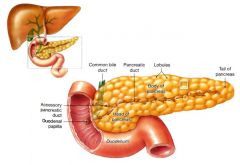
|
|
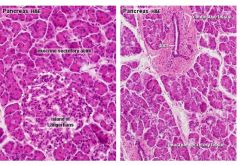
Exocrine functions pancreas |
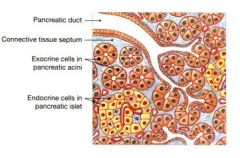
|
|
|
Endocrine functions
|
|

